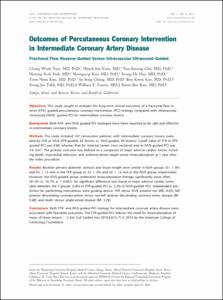KUMEL Repository
1. Journal Papers (연구논문)
1. School of Medicine (의과대학)
Dept. of Internal Medicine (내과학)
Outcomes of Percutaneous Coronary Intervention in Intermediate Coronary Artery Disease Fractional Flow Reserve–Guided Versus Intravascular Ultrasound–Guided
- Alternative Author(s)
- Nam, Chang Wook; Yoon, Hyuck Jun; Cho, Yun Kyeong; Park, Hyoung Seob; Kim, Hyung Seop; Hur, Seung Ho; Kim, Yoon Nyun; Kim, Kwon Bae; Chung, In Sung
- Journal Title
- JACC: Cardiovascular Interventions
- ISSN
- 1936-8798
- Issued Date
- 2010
- Keyword
- coronary angiography; fractional flow reserve; intravascular ultrasound; outcome; percutaneous coronary intervention
- Abstract
- Objectives:
This study sought to evaluate the long-term clinical outcomes of a fractional flow reserve (FFR)–guided percutaneous coronary intervention (PCI) strategy compared with intravascular ultrasound (IVUS)–guided PCI for intermediate coronary lesions.
Background:
Both FFR- and IVUS-guided PCI strategies have been reported to be safe and effective in intermediate coronary lesions.
Methods:
The study included 167 consecutive patients, with intermediate coronary lesions evaluated by FFR or IVUS (FFR-guided, 83 lesions vs. IVUS-guided, 94 lesions). Cutoff value of FFR in FFR-guided PCI was 0.80, whereas that for minimal lumen cross sectional area in IVUS-guided PCI was 4.0 mm2. The primary outcome was defined as a composite of major adverse cardiac events including death, myocardial infarction, and ischemia-driven target vessel revascularization at 1 year after the index procedure.
Results:
Baseline percent diameter stenosis and lesion length were similar in both groups (51 ± 8% and 24 ± 12 mm in the FFR group vs. 52 ± 8% and 24 ± 13 mm in the IVUS group, respectively). However, the IVUS-guided group underwent revascularization therapy significantly more often (91.5% vs. 33.7%, p < 0.001). No significant difference was found in major adverse cardiac event rates between the 2 groups (3.6% in FFR-guided PCI vs. 3.2% in IVUS-guided PCI). Independent predictors for performing intervention were guiding device: FFR versus IVUS (relative risk [RR]: 0.02); left anterior descending coronary artery versus non-left anterior descending coronary artery disease (RR: 5.60); and multi- versus single-vessel disease (RR: 3.28).
Conclusions:
Both FFR- and IVUS-guided PCI strategy for intermediate coronary artery disease were associated with favorable outcomes. The FFR-guided PCI reduces the need for revascularization of many of these lesions.
- Publisher
- School of Medicine
- Citation
- Chang-Wook Nam et al. (2010). Outcomes of Percutaneous Coronary Intervention in Intermediate Coronary Artery Disease Fractional Flow Reserve–Guided Versus Intravascular Ultrasound–Guided. JACC: Cardiovascular Interventions, 3(8), 812–817. doi: 10.1016/j.jcin.2010.04.016
- Type
- Article
- ISSN
- 1936-8798
- 파일 목록
-
-
Download
 oak-aaa-2642.pdf
기타 데이터 / 411.68 kB / Adobe PDF
oak-aaa-2642.pdf
기타 데이터 / 411.68 kB / Adobe PDF
-
Items in Repository are protected by copyright, with all rights reserved, unless otherwise indicated.